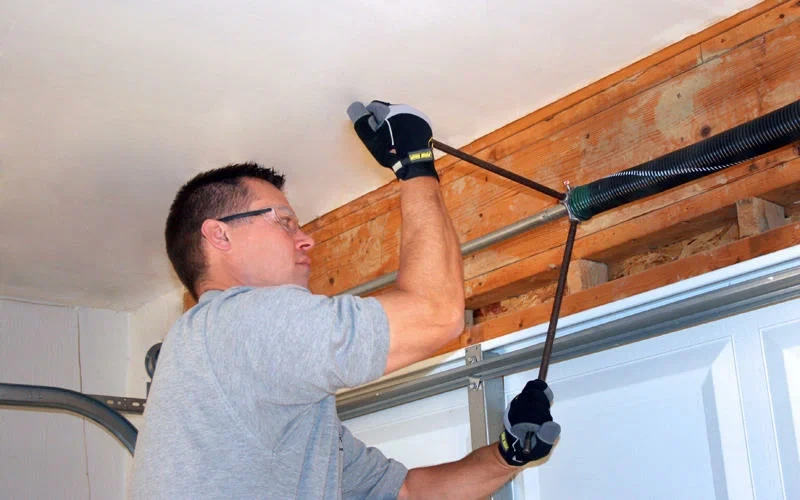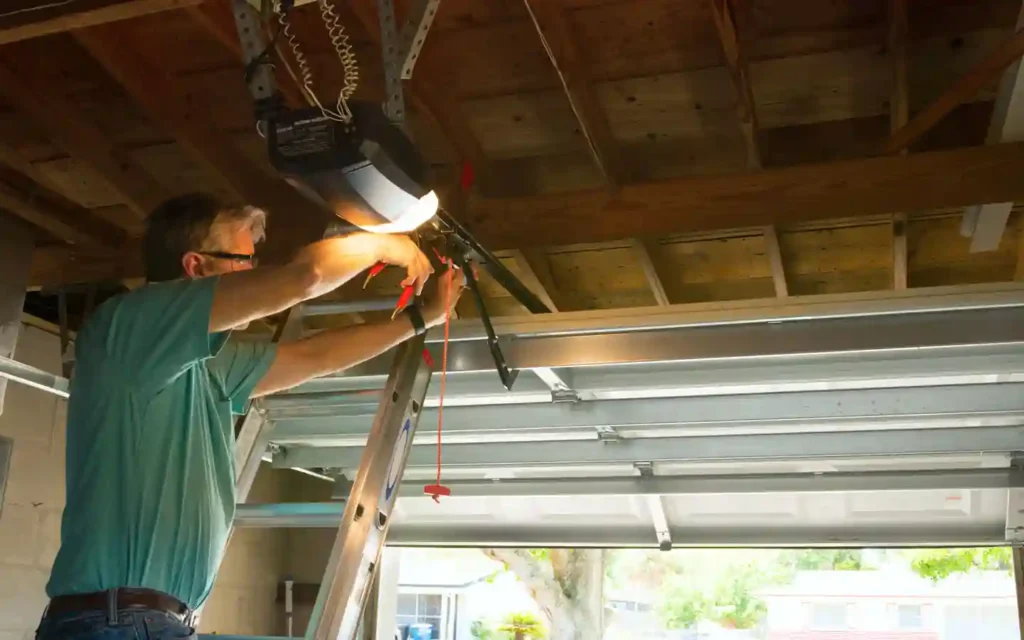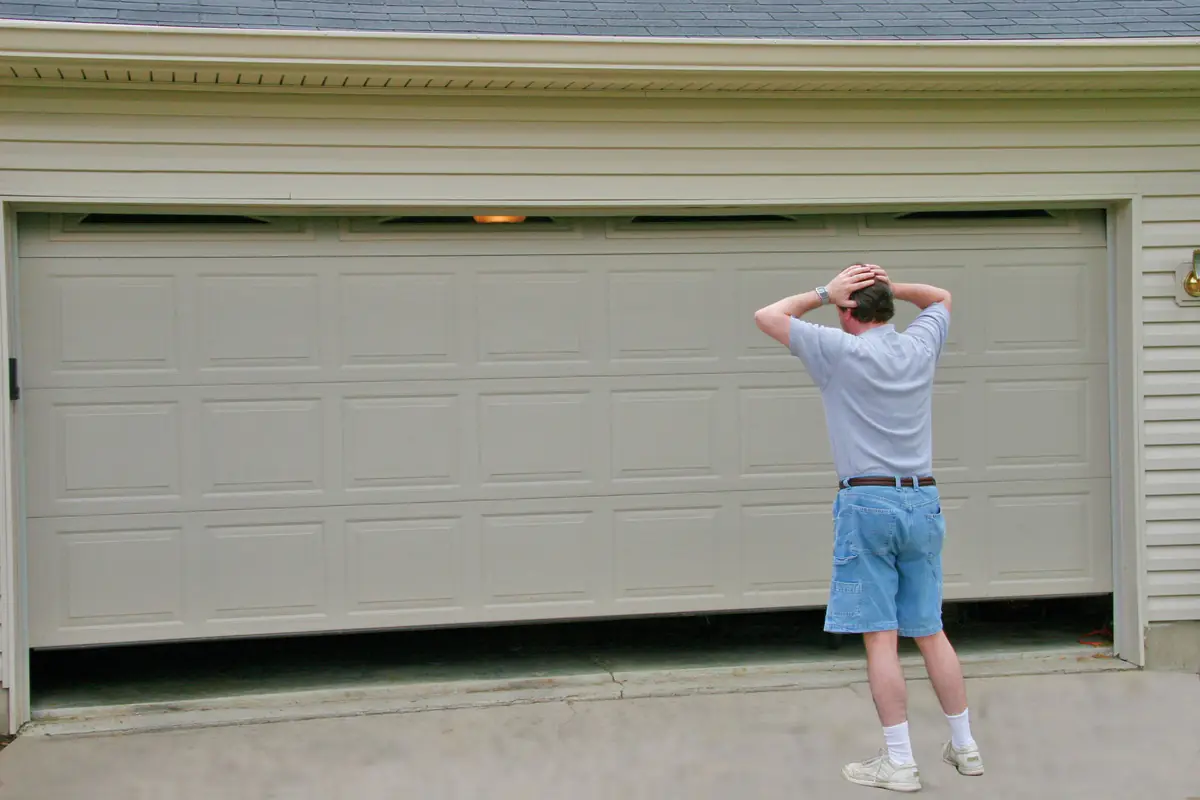A garage door not closing can be very annoying and may make your home less secure. Some problems will require a garage door repair expert, but many common issues can be fixed yourself.
This article will show you five simple ways to get your garage door closing properly again. This could help you save time and money
Key Takeaways
- A malfunctioning garage door can be a security risk, leaving your home vulnerable.
- Before calling for professional garage door repair, there are several easy fixes you can attempt yourself.
- This guide provides step-by-step solutions for common issues, from obstructed sensors to dead remote batteries.
- Learn how to troubleshoot problems with your garage door opener, sensors, remote, and tracks.
- Discover simple maintenance tips to keep your garage door springs running smoothly and securely.
Garage Door Not Closing – Initial Checks

When your garage door is stuck open, you should first check if it’s an easy problem or if you need a professional. Start by making sure your garage door opener motor is plugged in and that no circuit breakers have tripped.
Next, look for anything blocking the door’s path. Sometimes, things left close to the door can block its sensors and stop it from closing. Remove any toys, tools, or trash that could be stopping the door from working.
1. Ensuring Nothing Is Blocking the Door Path
Safety sensors are very important for how your garage door works. These sensors are on each side of the door, usually a few inches off the ground. They send out an unseen beam. If something gets in the way of this beam, the door stops closing because it thinks there is an obstruction.
Please check the area around the door to make sure nothing is blocking the sensors. Even a small item like a child’s toy or a garden tool can cause this issue.
If you have taken away any blockage and the door still does not close, look to see if the sensors need cleaning or rearranging. We will talk about this in the next steps.
2. Checking if the Power Supply Is Consistent
Believe it or not, a power surge or a temporary outage can sometimes stop your garage door opener from working. First, instead of checking the outlet, check to make sure the circuit breaker for your garage door is turned ‘on’.
If the breaker is tripped, reset it and then try closing the garage door. If it trips again, this may mean there is an electrical problem. In that case, you should call a qualified electrician and not try to fix it yourself.
However, if the breaker stays on and the power supply is steady, the problem is probably something else. You can then move on to the next steps to find the issue.
Common Issues with Sensors and How to Fix Them

Modern garage door issues have safety sensors, commonly known as photo eyes. They help prevent accidents. Sometimes, these sensors can get dirty or go out of line. This can cause false alerts and stop the door from closing properly.
The good news is that fixing these problems is easy. You can clean the sensors with a soft cloth and check their alignment. Let’s look at these solutions in more detail.
3. Cleaning Dusty Sensors for Clear Detection
Dust, cobwebs, and insects can mess up how your garage door’s safety sensors or photo eyes work. These sensors send out an invisible beam across the door opening. If something blocks this beam, even a little, the door will not close.
To clean the sensors, start by turning off the power to your garage door opener. This helps avoid any electrical problems. Next, find the sensors on each side of the door opening. They look like small boxes placed a few inches above the ground.
Take a clean, soft cloth and gently wipe away any dirt, cobwebs, or debris blocking the sensor lenses. After cleaning, turn the power back on for the opener and try to close the garage door.
4. Aligning Misaligned Sensors Properly

If cleaning your garage door sensors does not fix the problem, misalignment might be the issue. Even a small misalignment can stop the sensors from working properly. This can lead to your garage door not closing.
Many sensors have a tiny LED light that shows if they are aligned. If the light on one or both sensors is off or blinking, this means they are misaligned. To fix this, find the wing nut on the side of the sensor bracket.
Loosen the wing nut just a bit so you can change the sensor’s angle. Watch the LED light as you carefully adjust the sensor until the light stays on. Once the sensors are aligned, tighten the wing nut and test the garage door to see if it closes.
Troubleshooting Remote and Transmitter Problems
If you have checked the sensors and your garage door still won’t close, the issue may be with your remote control or the wall-mounted transmitter. These devices send signals to your garage door opener. If one is not working well, the door may not get the right signals.
The good news is that figuring out these problems is usually simple. It often just means replacing batteries or reprogramming the device. Let’s look at these solutions.
5. Replacing Dead Batteries in the Transmitter
One of the main reasons a garage door remote control doesn’t work right is a dead battery. Changing the battery is an easy fix that can quickly fix the problem.
Before you start, check your remote control’s manual to find out what type of battery you need. Usually, garage door remote controls use coin-cell batteries like CR2032 or CR2016, but it’s good to confirm.
Once you have the right battery, find the battery compartment on the back of your remote. It might be held in place by a small screw or have a sliding cover. After you put in the new battery, reassemble the remote and see if your garage door works.
6. Resetting or Reprogramming the Garage Door Remote
If changing the battery in your garage door remote does not fix the issue, the next thing to do is reset or reprogram it. The remote might lose its programming over time, especially after a power outage or when you change the battery.
The steps for resetting or reprogramming your garage door remote can be different based on the brand and model of your opener. Check your opener’s manual for exact instructions. It will show you the steps for your device.
In most cases, reprogramming means pressing a learn button on your opener, then following a certain button sequence on your remote. Make sure to follow the instructions closely. After you finish, test if your remote can now close the garage door.
Adjusting Settings and Components for Smooth Operation

If you have tried all the basic fixes and your garage door still isn’t working, you may need to adjust some settings or check its parts for damage.
Changing the limit settings or adding oil to moving parts can really help your garage door work better. Let’s look more closely at these solutions.
7. Fine-Tuning the Limit Settings for Proper Closure
Limit switches on your garage door opener control how far the door goes when it opens and closes. If the settings are not correct, your garage door might not close all the way or could go back up before it hits the ground. Luckily, most homeowners can adjust these settings themselves.
Check your garage door opener’s manual to find where the limit screws are and for any recommended changes. You will usually see two screws marked “up” and “down.” The “down” screw regulates both the closing strength and the distance.
With a screwdriver, slowly turn the “down” screw in small steps. Test the door each time you make an adjustment. Keep adjusting until the door closes all the way without using too much force. If you feel unsure about making these changes, it’s best to call a professional technician.
8. Lubricating the Tracks and Rollers for Unhindered Movement

Over time, your garage door roller and tracks can get dry or trap dirt and debris. This can cause friction and make the door harder to open and close. To keep everything working smoothly, you need to lubricate them on a regular basis.
Use a garage door lubricant made for this purpose. Don’t use WD-40 or oil-based sprays, as these can draw in dirt and dust, making things worse. Apply the lubricant on the tracks, especially in the spots where the rollers move.
Also, make sure to lubricate the hinges and any other metal parts that move. After you apply the lubricant, open and close the door a few times. This helps spread the lubricant evenly. By doing this simple maintenance, you can really improve the life and function of your garage door.
Conclusion
Is your garage door not closing well? Don’t worry, we have some simple fixes for you to try first. Make sure nothing is blocking the door’s path. Check the power supply and clean or align the sensors if needed. If you’re having issues with the remote, try changing the batteries or reprogramming it. You can adjust settings for better operation by fine-tuning limits and lubricating the tracks.
It’s important to keep your garage door in good shape for your safety and convenience. Regular maintenance can help you avoid problems in the future. If you still have issues, it might be best to ask a professional for help. Your garage door is a key part of your daily life, so keeping it working well is important for a hassle-free experience.
Frequently Asked Questions
1. Why does my garage door not closing halfway down?
Your garage door might not be working because of three main reasons. It could have a limit setting problem, blocked sensors, or issues with the torsion springs. If cleaning and making adjustments don’t help, you can call a garage door repair professional. They can figure out the problem related to the weight of your garage door and help fix it.
2. Can weather affect my garage door’s ability to close?
Yes, extreme weather can change how your garage door is aligned and affect its parts, like the safety sensors. It’s important to check your door’s alignment regularly. Make sure all the parts are clean and clear of debris, especially after bad weather.
3. What should I do if my garage door remote is lost or broken?
If you lose your remote control, you can buy a new one using the model number from your opener. If it’s broken, try to reprogram it first. If that doesn’t work, you should call a garage door technician for a service call to replace the remote control.
4. How often should I perform maintenance checks on my garage door?
Regular maintenance keeps your garage door working well. You should schedule garage door maintenance two times a year. This means checking and cleaning key components, lubricating moving parts, and testing the opener.
5. Is it safe to adjust the tension springs on my garage door by myself?
No, it is very dangerous to adjust tension springs. It is better to leave this job to a skilled garage door technician. These springs are under a lot of pressure and can hurt you if not handled correctly. Always put safety first and do not try to fix garage door tension springs on your own.
6. How to fix a garage door when it won’t close?
If your garage door not closing, try some troubleshooting steps. First, check for any obstructions. Next, test the opener. You can also look at your manual for help. If these simple fixes do not work, you should reach out to professional garage door repair services. They can assist you with the limit switches.
7. Why is my garage door not closing all the way and goes back up?
If your garage door goes the wrong way, it may be because of the sensors, misalignment in the tracks, or it might need a limit adjustment. Look for anything blocking the door. Clean the sensors and check the tracks for any problems you can see. You might also need to adjust the limits.
8. Why won’t my garage door close and light blinks?
Flashing lights on your garage door opener usually mean there is a problem with the sensors. First, check for any blockages or if the sensors are out of alignment. If you still have the same problem, there might be an issue with the sensor or the wiring. You might want to get professional help to fix the malfunction.
9. How do I reset my garage door?
Resetting your garage door opener can help fix small problems. First, unplug the opener to reset it. If that doesn’t work, using the bypass mode or changing the limit screws is better done by a professional.

